SCOUTED: How to scout South America like Brighton
.png)
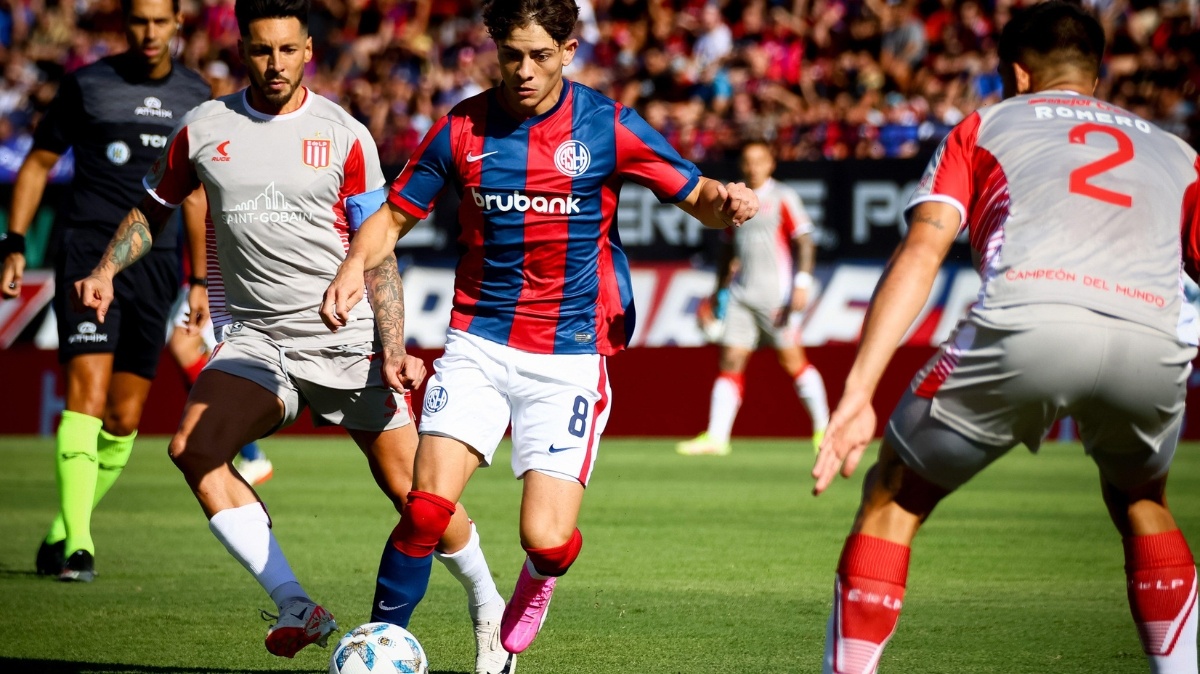
SkillCorner has partnered with Scouted Football, providing data and insights to support their writing on the best emerging talent in football.
In this article, the Scouted team used Physical and Game Intelligence data to analyse Brighton's successful recent recruitment of South American players, and discuss how other clubs might emulate the approach.
Brighton. Their recruiting practices are the toast of the Premier League. Their leading recruitment staff, such as Paul Winstanley, Dan Ashworth, and more recently, Sam Jewell, have been poached by the league’s biggest clubs in hopes of nabbing the ingredients to Brighton’s secret recipe.
But there is an art to recruitment. It begins with finding and identifying players, sure, but that’s not the end of what makes a transfer ‘work’. Brighton have found much success scouring the world for talents, but their delicate, measured approach to embedding them — eventually — into the first team has been key to their overall success.
For more on that, we published an essay last summer, our most popular ever, called Brighton’s hidden aces by the tremendously talented Billy Carpenter.
For now, let’s focus on step one: finding the players in the first place. Let’s turn our eyes to Brighton’s favourite market, South America, in search of unearthed stars.
By looking backwards at the kinds of players Brighton have historically pulled from the continent, we’ll be able to spot trends and develop insights into what exactly they’re looking for when they go scouting — and how other clubs might follow suit.
What are Brighton looking for in a footballer?
Brighton play a certain style, and are looking for a certain player.
This is step one: knowing the type of player that fits the ethos and tactical approach your club wants to play. This is not a one-size-fits-all model, and for Brighton this approach means looking for technical competency above all else. They generally aren’t looking for the best athletes.
Looking for athleticism at such an early age can be a bit of a fools’ errand anyway, especially given Brighton are signing teenagers with huge room for development in their approaching years — development the club can guide once they have the player in house.
Therefore, technique is everything for Brighton. A strong technical foundation is developed very early on in a player’s career and becomes increasingly hard to improve as players get older. Even lacking a PhD in biomechanics, it seems patently obvious that so many important motor skills - that grouped together become what we moniker ‘technique’ - are developed early in a player’s career, or before it’s even started. So, technique becomes the critical factor.
And when searching for signifiers of technical competency, one suite of insights in the SkillCorner data package we’ll be using to scout stands head and shoulders above the rest: Overcoming Pressure.
Before we tuck in, technical quality is not the only thing that goes into Overcoming Pressure. If you’ve been following my SCOUTED50 profiles, you’ll see how I’ve looked at different player’s ability to withstand high pressure, and the physical elements that can help a player to do so. For extra context, read our profiles on Gianluca Prestianni, Johan Bakayoko and Lamine Yamal.
Alas, technical ability is still the key feature, and young players excelling in overcoming high pressure despite being undersized should be treated very seriously.
The Brighton Way
Let’s step back and take a look at what Brighton are. There are no two metrics that define the way they play more than their ability to retain the ball and complete passes under pressure.
For both metrics, they rank third in the Premier League behind only Manchester City and Arsenal, with a 79.8% ball retention ratio and 84.6% pass completion ratio under high pressure.
As you can see from the table below, each club’s ball retention ratio under high pressure rating correlates quite closely with their league position. Bournemouth, Liverpool, West Ham and Everton (disregarding the points deduction) are the biggest outliers, each ranked higher on the table than this metric would suggest, while Brighton, Burnley and Chelsea are the inverse.
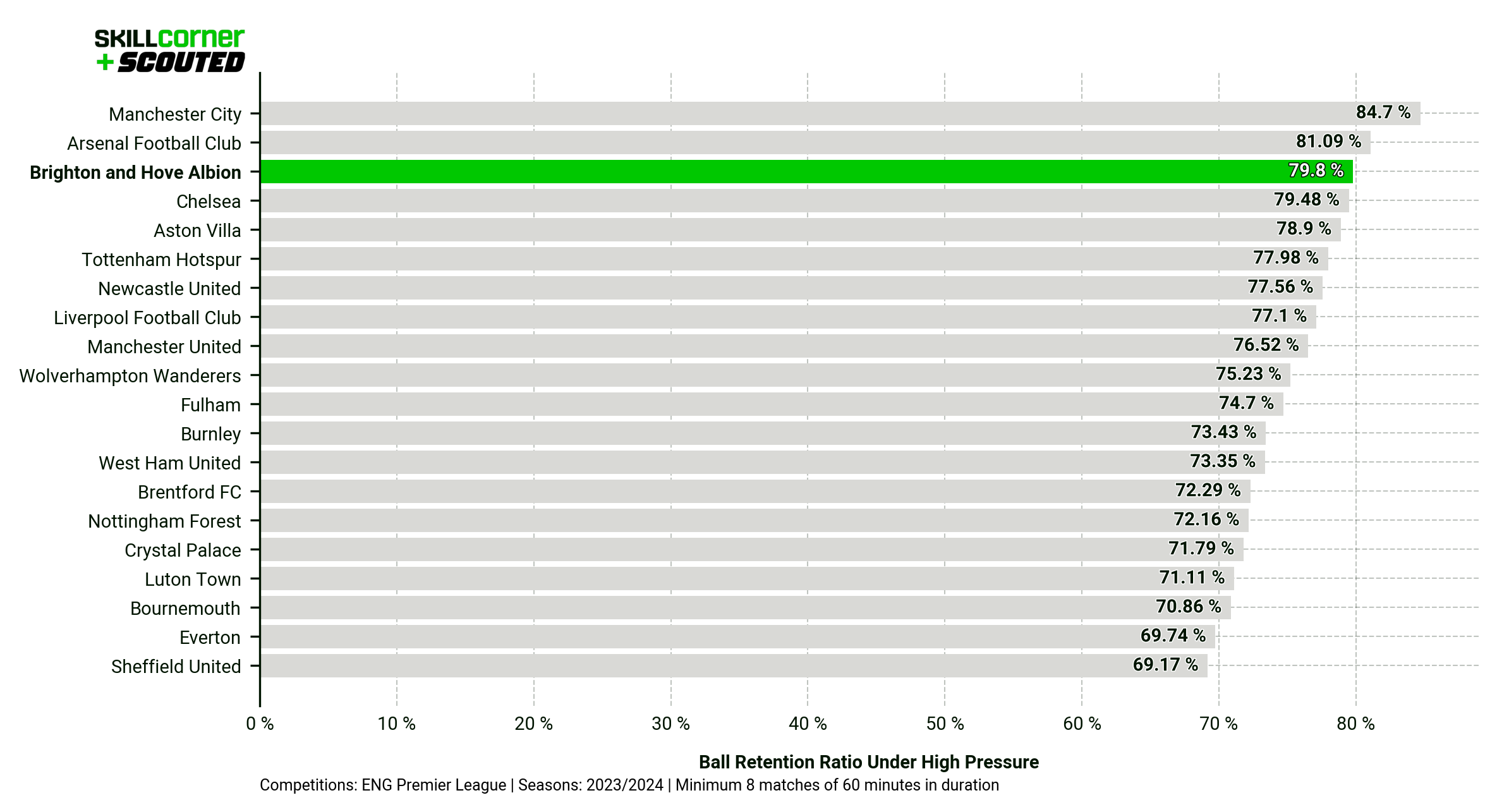
Clearly, Brighton need to recruit players that suit these two metrics — it is incredibly central to their stylistic approach as a football club. And that’s not just under Roberto de Zerbi. They have been improving in this area basically from 2018/19 onwards, which was the first Premier League season we have data available from.
But De Zerbi is a key part of the story, and a culmination of the effort Brighton have made in this direction. As you can see below, a key feature of De Zerbi’s teams at Sassuolo, Shakhtar, and now Brighton, is growth and then consistent excellence in retaining possession under pressure.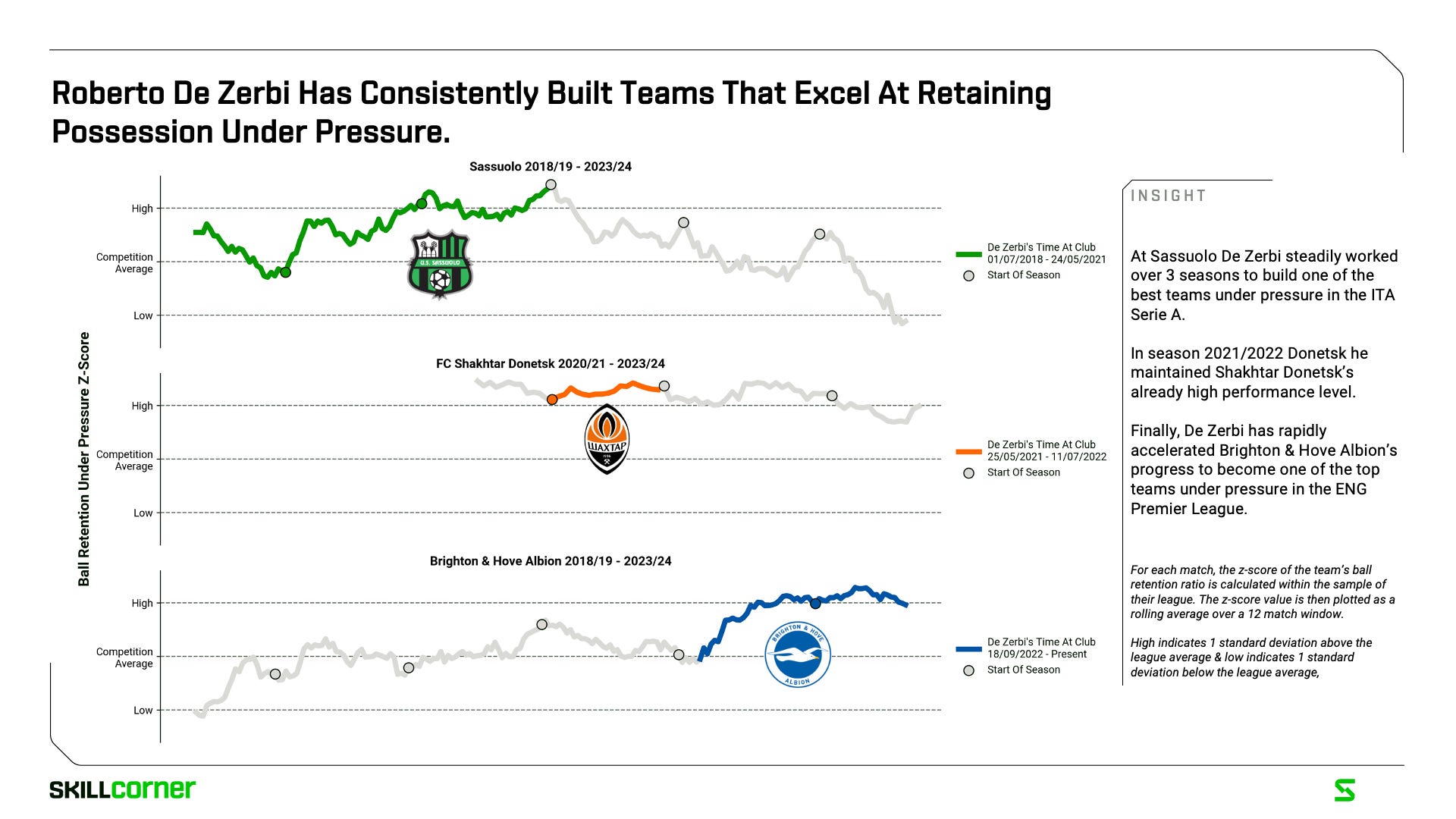
The growth element is fundamental. Taking a group of players who on the macro level are already very technically strong, and then embarking on a more micro-focused approach to maximising this ability is De Zerbi’s modus operandi.
By now we’ve all heard the anecdote of him telling players to receive the ball with the sole of their boot to entice the press, but that’s become cliché for a reason: it’s a great example of how to give a technical player fresh ideas to make the most of their ability.
The proof is in the pudding. Here is the impact De Zerbi’s approach had on Brighton’s players on an individual level just one season after his takeover early in 2022/23:

So, in simple terms, what does the ‘Brighton Model’ mean?
It means to recruit players with excellent technical fundamentals, work out whether a short loan may be beneficial (as with Moises Caicedo, Kaoru Mitoma, etc), then hand them over to one of the best technical development coaches in the sport.
So, now we know what we’re looking for and why, let’s turn our eyes to South America, with our two metrics — ball retention ratio and pass completion ratio under high pressure (I am told by our good friends at SkillCorner that these stats are 96% correlated) — safely in hand.
Let the scouting begin.
The Shortlist
After filtering for ages to give me a bunch of players born 2003 or after, my first quick little search through South America left me with a list of about 25 players.
Intriguingly, it threw up a lot of players that have already moved clubs. Including, but not limited to:
Ignacio Miramón: Gimnasia to LOSC Lille, 4M€
Gino Infantino: Rosario Central to Fiorentina, 3M€
Breno Lemos: America-MG to Shabab Al-Ahli, 4M€
Enso González: Libertad to Wolves, 6M€
Gabriel Moscardo: Corinthians to PSG, 20M€
Lucas Beraldo: Sao Paulo to PSG, 20M€
Marlon Gomes: Vasco da Gama to Shakhtar, 12M€
Valentín Barco: Boca Juniors to… Brighton, 9M€
This assured me I was on the right track. Many of these players have been playing youth international football for their countries too, and we got to see a bit of what they can do at the Under-20 World Cup last year.
My full list of players will remain classified under lock and key (clubs, this is available for purchase, we accept all forms of popular payment - ed), but it's only fair that I share a few names with you.
So, here’s a mix: one player from Ecuador, one from Brazil, and one from Argentina.
🇪🇨 Óscar Zambrano (2004, CM, LDU Quito)
Games played (60 mins+): 18, all senior comps in 2023
Ball retention ratio under high pressure: 90.2%
Passing completion ratio under high pressure: 91.3%
The number one player who exploded off my screen was LDU Quito’s Óscar Zambrano. A lot of our readers will already be familiar with him; we covered him extensively last year during the U-20 World Cup, and if you missed him then, you’re likely to have seen his name linked to a January move to Bournemouth.
We even picked out Brighton as a an ideal potential landing spot in early August:
The headline stats are compelling: he musters 90.2% and 91.3% ratios for ball retention and pass completion under high pressure respectively. That is top, top tier.
It is worth giving a little bit of context to these numbers though, given that Zambrano plays in a LDU team that ranked second in Ecuador in this metric in 2023.

Midfielders also tend to perform the best when it comes to retaining possession under pressure. That’s only natural — they generally have the most angles available to them to evade it without being hemmed in by the confines of the pitch.
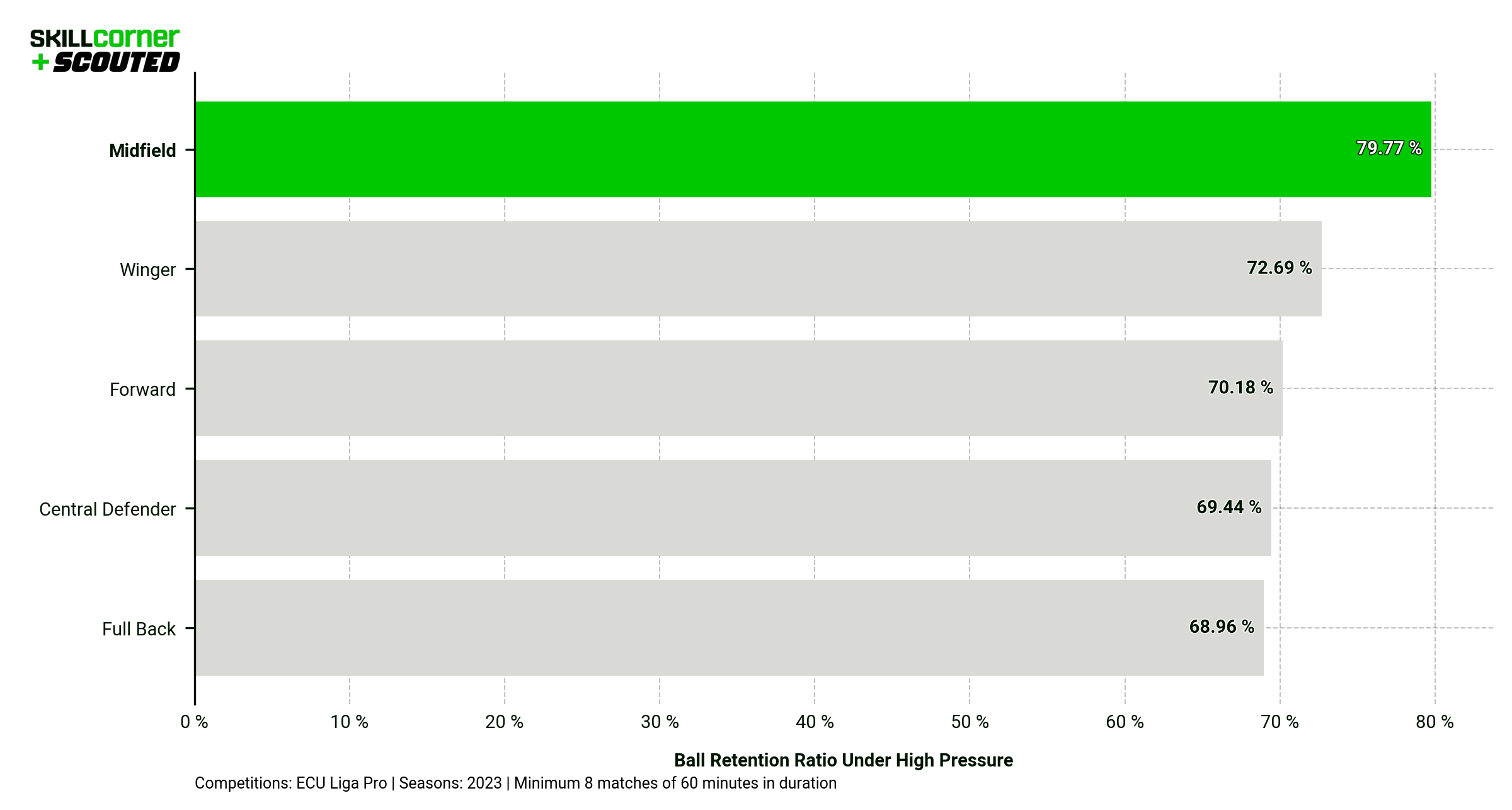
Zambrano was the only player with a worthwhile sample size and a 90%+ ball retention ratio under high pressure. That is mega.
But what exactly is Óscar Zambrano like as a player?
The Ecuadorian is a busy controller. The natural comparison would be to his compatriot Moisés Caicedo, although Zambrano’s game revolves a bit more around what he can do with the ball, in contrast to the more athletically dominant Caicedo.
Zambrano can do a bit of everything; he’s played minutes as both a six and an eight for Quito, and adjusts his game to suit both roles well. In either, his style is to control the ball and use it efficiently, although he is admittedly risk-averse.
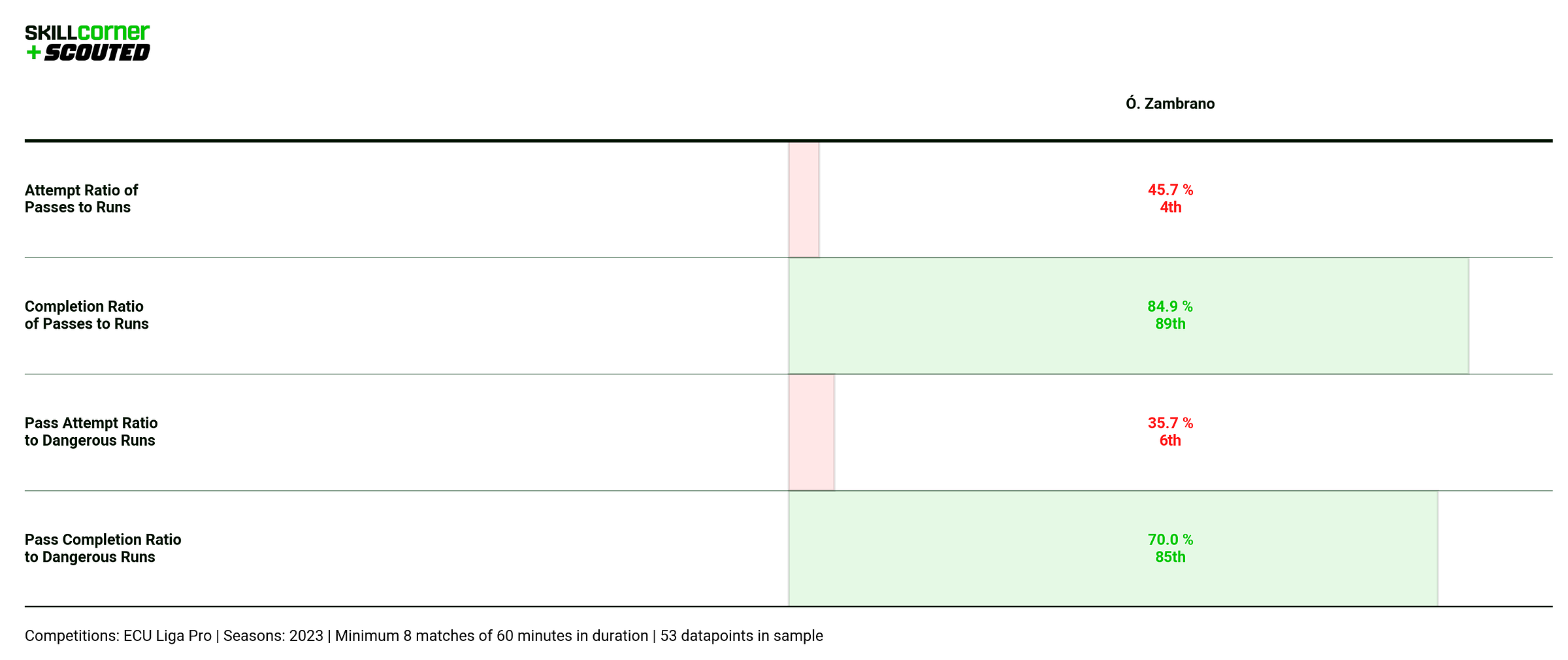
His low attempt ratio but high completion ratio of passes to dangerous runs illustrates this quite clearly. One could argue he should be more aggressive with his distribution, but one must take into account that LDU’s style is centred around control — they aren’t looking for a single pass to break games open.
During second stage of the 2023 Ecuadorian LigaPro, they conceded just four goals in 15 matches on their way to lifting the title. They know how to keep games calm.
But as a result of this they were also in the bottom half of teams in Ecuador for Dangerous Runs per 30 TIP.

Again, interestingly, the exact same thing can be said about Brighton (plus the other strong high possession and control clubs, Arsenal and Manchester City), and contrasts with the back-and-forth style we’ve come to expect from teams like Tottenham and Liverpool.
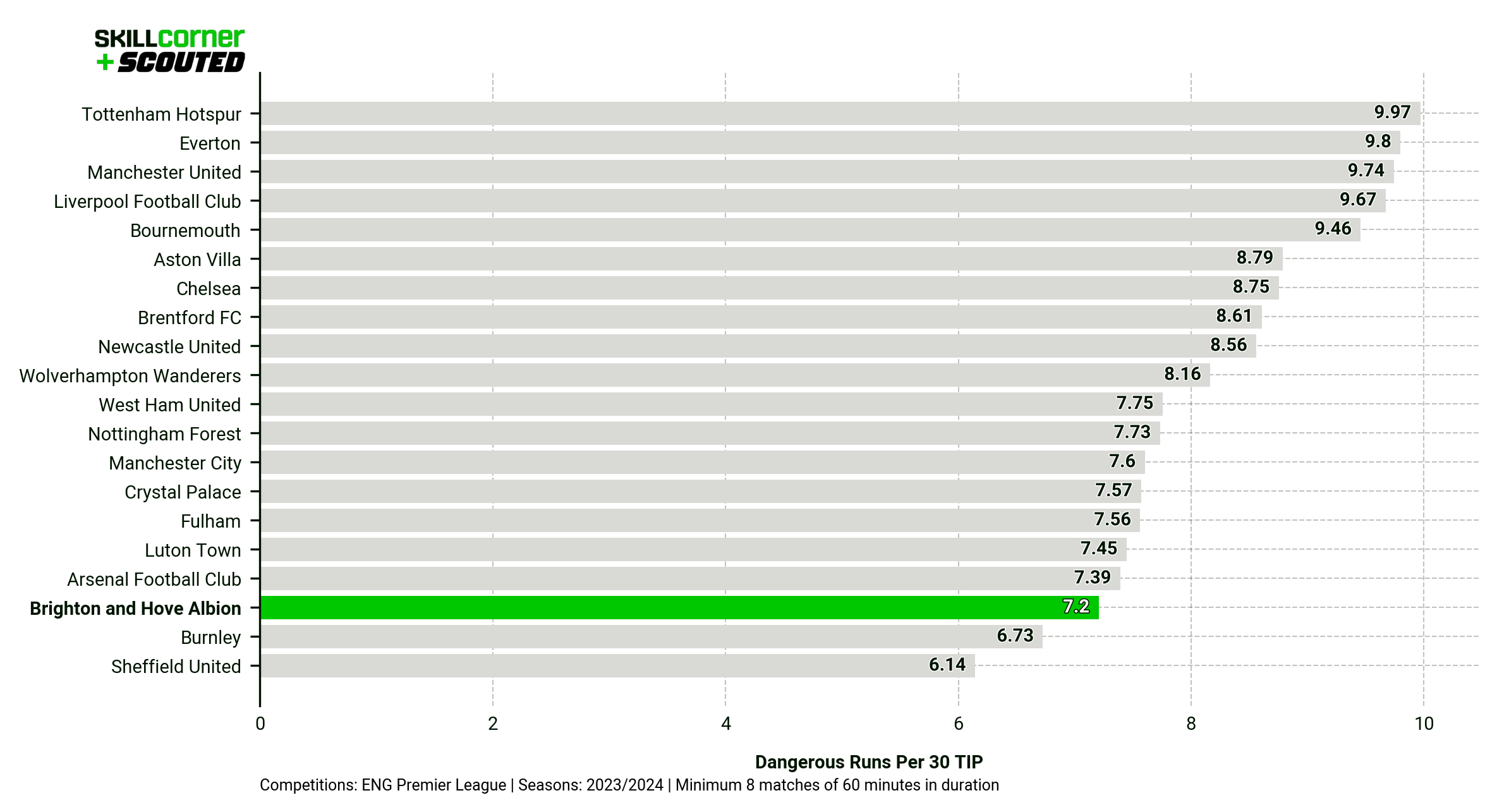
🇧🇷 Victor Hugo (2004, CM, Flamengo)
Games played (60 mins+): 12, all senior comps in 2023
Ball retention ratio under high pressure: 82.3%
Passing completion ratio under high pressure: 86.1%
The timing on this? Impeccable. If you want a wider dissertation on Victor Hugo, you can read a piece we released on him earlier this year.
Young Victor has fallen slightly out of favour at Flamengo since the arrival of former Brazil manager Tite, so he presents as a very ‘gettable’ player in the summer.
Not too long ago it was Wolves who made a splash to try to sign the young Brazilian. Who might be next?
Like Zambrano, Hugo plays in one of the best teams in his league; a Flamengo side that has been ever-present in Brasileirão title races for a solid half-dozen years now.
Like LDU, in 2023 they were very effective as a unit at retaining the ball under high pressure.

It is a tad difficult to get a gauge on Hugo, considering he played a range of positions through the midfield and on the wing in 2023, but let’s give it a go anyway.
He’s played most of his minutes in midfield as an interior, so we’ll focus there.
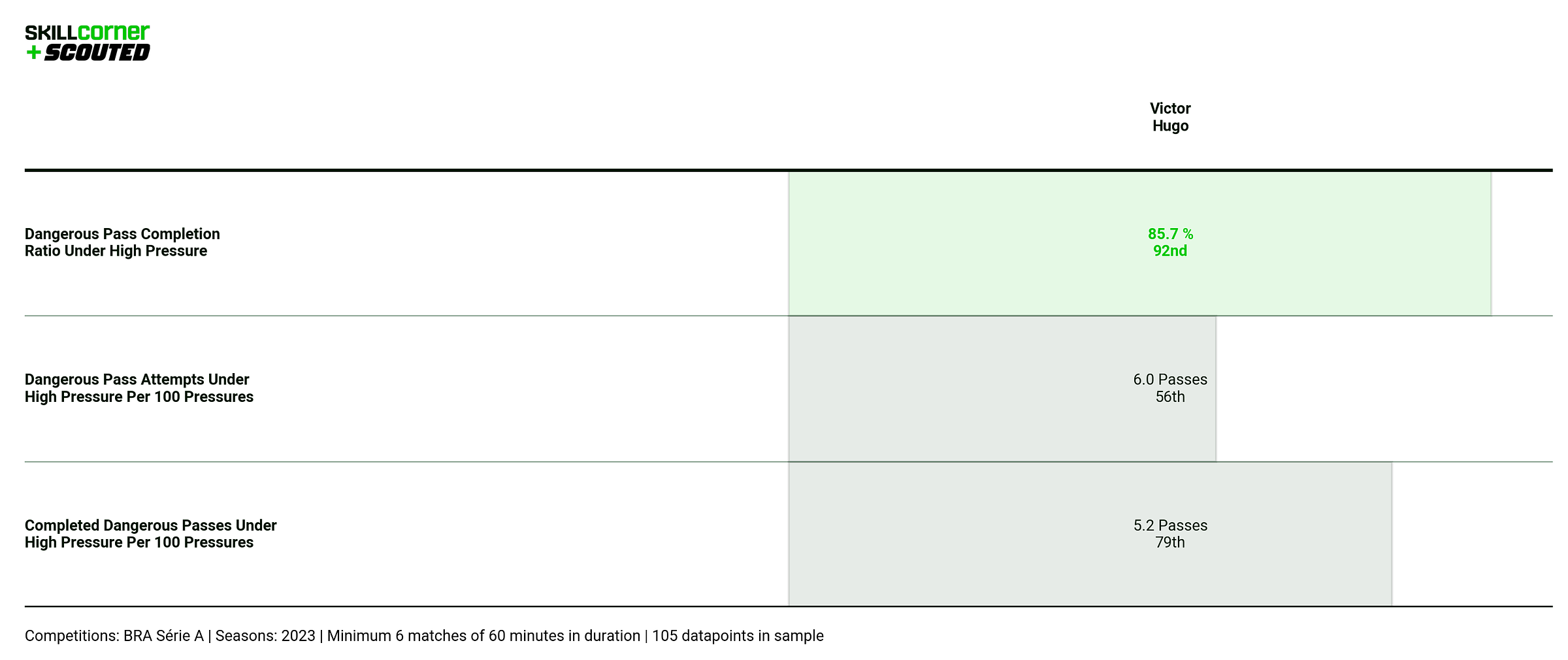
Again, like Zambrano, he’s super efficient. Although, Hugo also brings volume in dangerous passing. He is super silky, with outstanding close control — he definitely has more of a forward-thinking approach than Zambrano, which is why Zambrano profiles slightly better as a six than an eight.
Hugo’s shift into senior football, moving from playing as a more traditional number ten to playing as an interior, should hold him in good stead for a move to Europe. He is not a crazy runner, but there’s a certain je ne sais quoi — a dynamism — to his game. He’s got a compact frame and shifts his body weight from side to side effortlessly. It’s a great skillset for a number eight in a high possession team. Get him working in the pockets, feed him the ball, and let him work things out. He’s pretty good at doing that.
At the end of the day, this is why talent ID is so important. Victor Hugo is not a player for West Ham or Everton. A club that signs him must maximise his technical strengths and passing ability, rather than trying to work around whatever weaknesses he may have athletically.
🇦🇷 Agustín Giay (2004, RB, San Lorenzo)
Games played (60 mins+): 24, all senior comps in 2023
Ball retention ratio under high pressure: 70.3%
Passing completion ratio under high pressure: 69%
Brighton’s signing of Valentín Barco was their first (nominally) non-midfielder/attacker signing from South America.
So, naturally, we couldn't finish this piece off without going full-back shopping. Our search led us back to Argentina, where we stumbled upon San Lorenzo’s Agustín Giay.
His headline numbers don’t jump off the screen like Zambrano’s and Hugo’s, but let’s quickly contextualise why they’re still quite impressive.
While he is operating at team average in an above average team in Argentina…

…he is performing well above his positional group average.
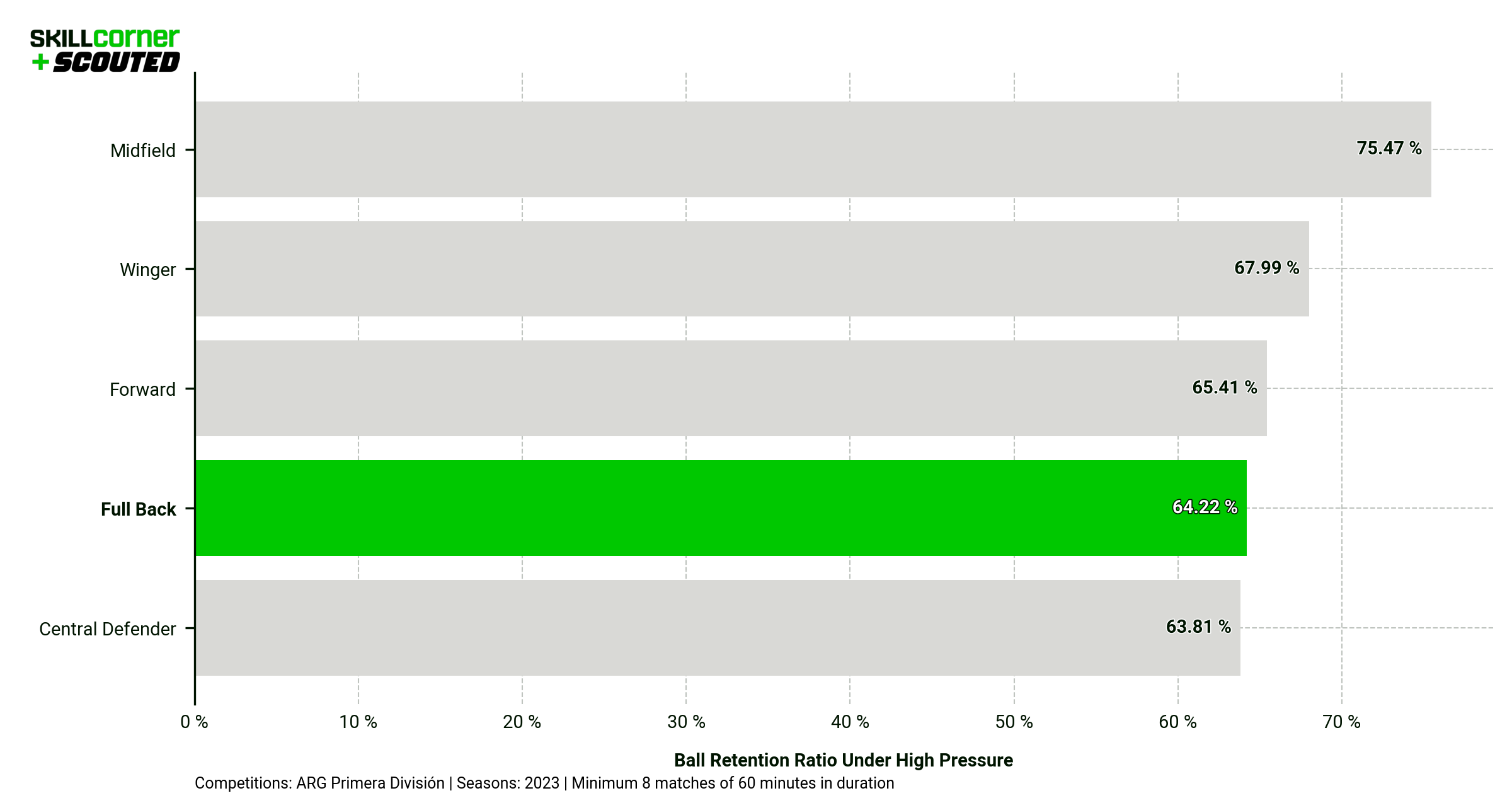
It is also worth noting that Argentina’s first division is lower ranked than Ecuador’s, Brazil’s, the Copa Sudamericana AND the Copa Libertadores for ball retention under high pressure.
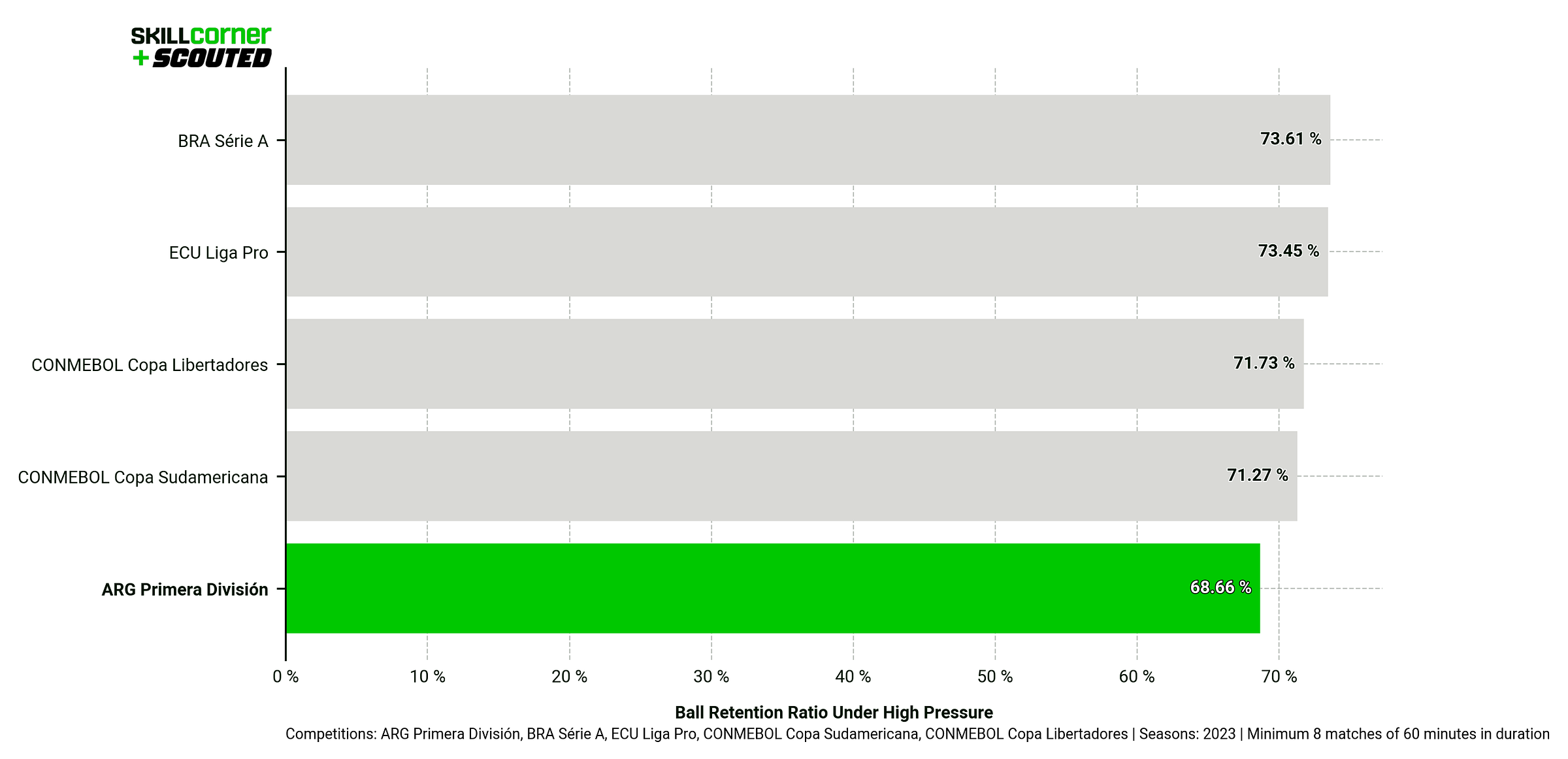
Next, let’s do a comparison to Barco.
Here’s Barco in his minutes in Argentina and the Copa Libertadores in 2023 as a full-back compared to Giay in Argentina and the Copa Sudamericana:
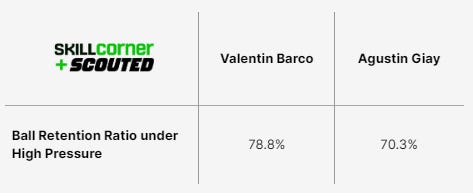
A bit of a gap, but contextualised through team performance, it’s a fair bit closer than it first appears.
And finally, let’s throw Giay in amongst players born in 2001 or later with 6+ appearances of 60+ minutes (Barco is a non-qualifier) as a full-back in Argentina in 2023:
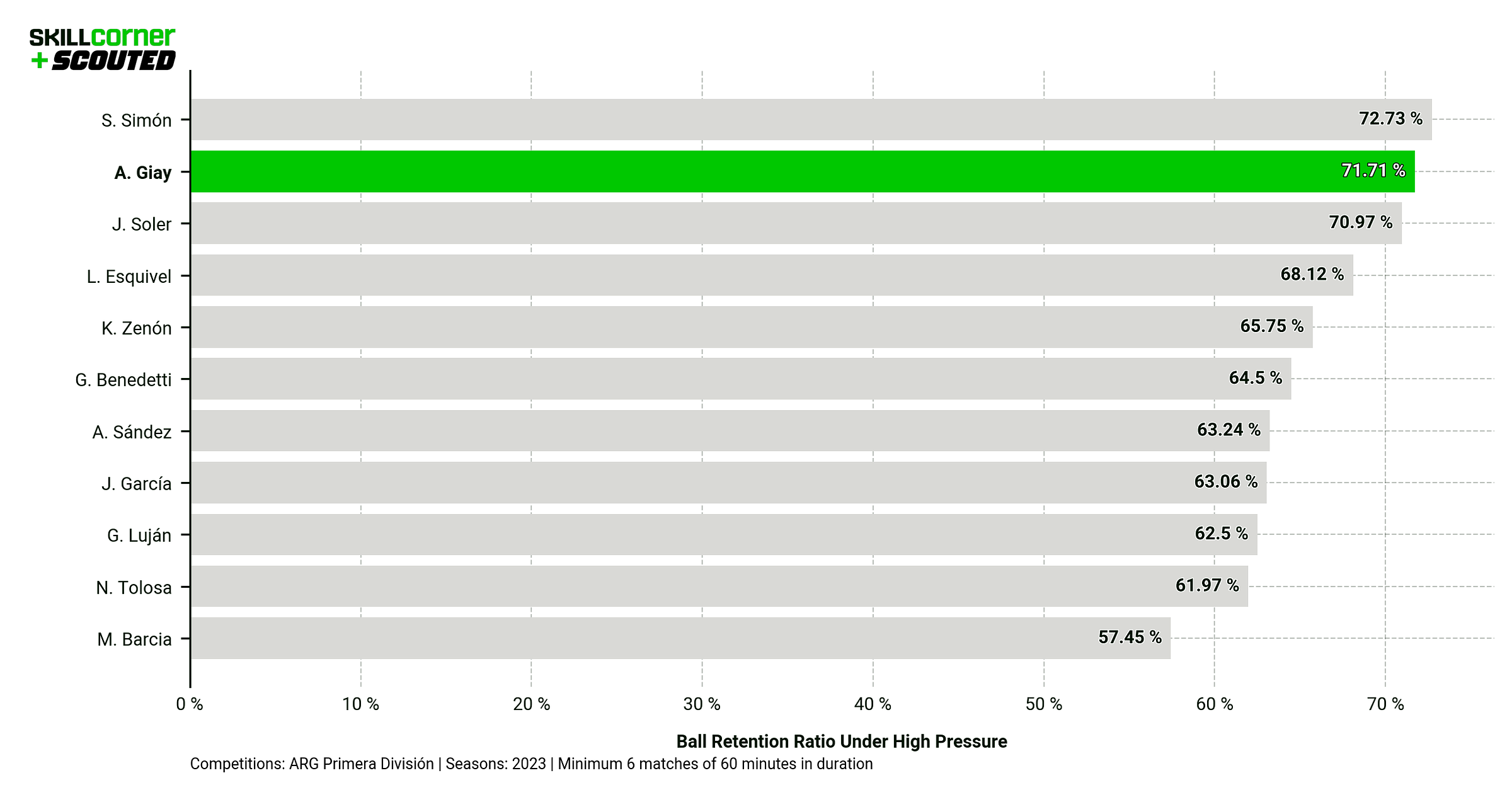
After all that, we can say that he’s pretty darn good.
The first thing I noticed watching tape of Giay was his natural tendency to invert as a ball-carrier. That’s a big tick; something I think a team like Brighton would be looking for.
If a player is comfortable inverting from full-back, they open up so many channels for the attack to move through. Generally, less technical full-backs are less inclined to risk doing so — losing the ball in these positions also creates more danger.
Players like Giay are vitally important for controlled possession sides. Their positionally fluidity asks questions of the opposition’s defensive structure and helps facilitate overloads in certain positions.
Valentín Barco is the archetype of this kind of player, and that's why Brighton were so keen to sign him.
Giay is a little different though. He’s a bit rougher around the edges, but certainly brings more of a defensive ruggedness in duels than his compatriot, as well as a bit more running power.
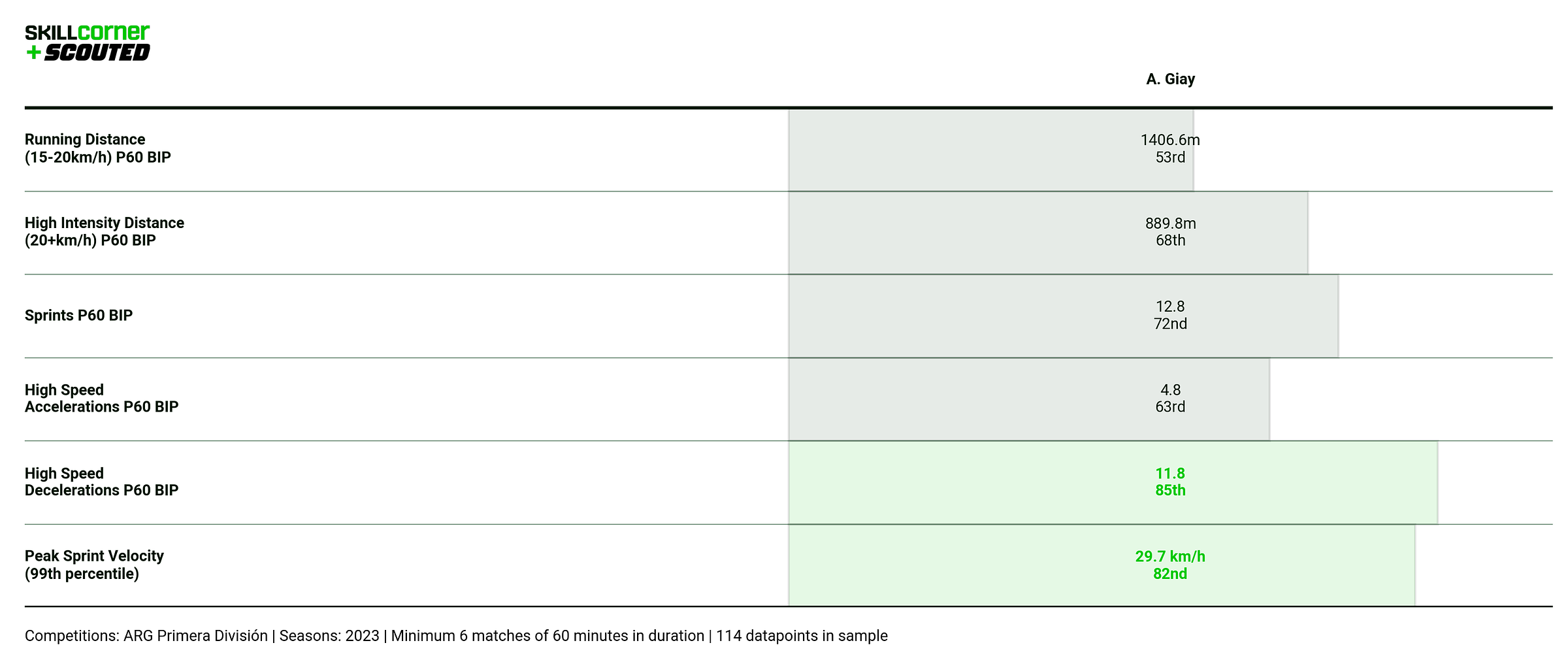
Giay would probably represent a project player for a team like Brighton. His athletic profile would make him a success on loan at many clubs in a solid European league, and his technical profile looks malleable for a coach like De Zerbi.
Conclusion
Value is in the eye of the beholder. For Brighton, it's technicality first - and we went scouting for players who embody that.
But as I noted at the start, there’s no one-size-fits-all approach to recruitment. What kind of player didn't get picked up through my filter for ball retention under high pressure?
Well, someone like new Barcelona signing Vitor Roque, for example.
The lesson for clubs is not that they have to follow the ‘Brighton model', but that they have to find out what their own model is. What metrics are important to their style of play?
For some clubs, their style might draw them to freakish athletic outliers and off-ball running demons. Once a club hones its parameters comes the next crucially important aspect: development and integration into the first team.
The Brighton model doesn't start and finish with recruitment — but it is a crucial first step.
Written by Steven Ganavas.
Click here for more information on our football products.
Click here for more of Scouted's writing on emerging football talent.